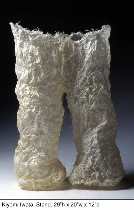
I’m ashamed to say I didn’t make it to Snyderman’s “Fiber Biennial 2004” until Thursday, but boy am I glad I made it. And so will you be if you rush on over. It closes Friday, the 30th.
As ever, the state of what constitutes fiber in this show is so broad that I’m wondering why the curator, Bruce Hoffman, didn’t include some canvases covered with paint. Just kidding. But only a little.
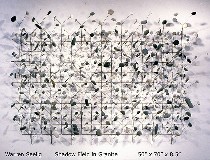 Take Warren Seelig’s “Shadow Field in Granite” (shown). This piece was made of rods of metal and stone, but the suggestion of the grid and stitchery got it included in the show. It reminded me, by the way, of some Charles Fahlen work back when he was in love with rods and rocks and mountains and such.
Take Warren Seelig’s “Shadow Field in Granite” (shown). This piece was made of rods of metal and stone, but the suggestion of the grid and stitchery got it included in the show. It reminded me, by the way, of some Charles Fahlen work back when he was in love with rods and rocks and mountains and such.
Baskets and anti-baskets
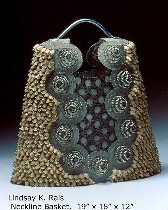
Lindsay K. Rais’ “Neckline Basket” was a basket only by virtue of having a handle; it was bottomless. As for the fiber, it consisted of pistachio nuts and screening. But it evoked clothing (that’s fiber, ain’t it) and jewelry, and Indian goddesses with lots of breasts.
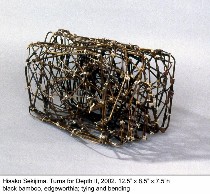
Basket-making’s tradition runs the gamut in this show. Take Hisako Sekijima’s “Turns for Depth II,” woven and tied twigs that hold–woven and tied twigs. It’s a lacy solid that speaks of concentration and control over wild things that cannot quite be controlled–a little cage of itself.
And Kiyomi Iwata’s “Stand” (shown at top) and “Peach Two” were also nonfunctional. Paper, stiffened and woven with delicate wire in a loose grid, became human vessels, vulnerable and airy.
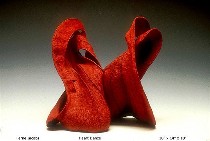 For unlikely subject-matter in the world of basketry, Ferne Jacobs offered her three-D explosions of knot-making (shown at top, “Heart Dance”). Her “Open Globe” took a globe of the world (sort of) and turned it into a freeform vessel. Another artist whose sculptural shapes seemed like surprises were Karyl Sisson’s constructions of ribbon or cloth tape and clothespins.
For unlikely subject-matter in the world of basketry, Ferne Jacobs offered her three-D explosions of knot-making (shown at top, “Heart Dance”). Her “Open Globe” took a globe of the world (sort of) and turned it into a freeform vessel. Another artist whose sculptural shapes seemed like surprises were Karyl Sisson’s constructions of ribbon or cloth tape and clothespins.
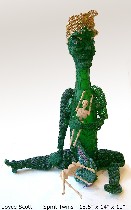 With what looked like knots and mixed media, Joyce Scott created talismans and fetishes. Here’s a picture of her “Spirit Twins,” the green mother a gal not to be messed with. I’m not so sure I want to mess with the twins either.
With what looked like knots and mixed media, Joyce Scott created talismans and fetishes. Here’s a picture of her “Spirit Twins,” the green mother a gal not to be messed with. I’m not so sure I want to mess with the twins either.
Humorous twists
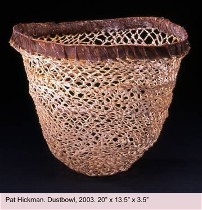
In a world that usually doesn’t have time for a sense of humor (how can you have a sense of humor when the labor required to make any of these pieces amounts to self-flagellation?), there was Pat Hickman’s “Dust Bowl,” a sort of joke–more like a dust sifter. And K. Pannepacker’s “7000 Q-tips,” a fairly conventional weaving except for the 7000 Q-tips interwoven and creating the strips, made me laugh. It was created at the Fringe Festival (can you believe this joke?), with audience participation in the cutting-off ceremony.
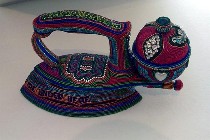 And speaking of humor, Tom Wegman’s beaded found objects had a Pop Art, cartoony sensibility. I was thinking about Red Grooms when I looked at his toasters and irons. At the same time, this was full-bore, obsessive folk art.
And speaking of humor, Tom Wegman’s beaded found objects had a Pop Art, cartoony sensibility. I was thinking about Red Grooms when I looked at his toasters and irons. At the same time, this was full-bore, obsessive folk art.
I’d put Barbara-Rose Okun’s little picture weavings (maybe macrame knottings) (alas, not shown) somewhere close. Her “Texas Longhorns Summering in New Mexico” and “Up to My Ears in Snow” tickled me with their quirkiness and intensity, fitting whole landscapes into about 24 square inches.
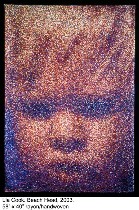 Anyway, even with more traditional means and materials–jacquard weavings (shown, Lia Cook’s “Beach Head”), needlepoint, embroidery, applique, quilting, much of the work had a twist of some kind that made it feel modern, conceptual or otherwise more art than craft.
Anyway, even with more traditional means and materials–jacquard weavings (shown, Lia Cook’s “Beach Head”), needlepoint, embroidery, applique, quilting, much of the work had a twist of some kind that made it feel modern, conceptual or otherwise more art than craft.









